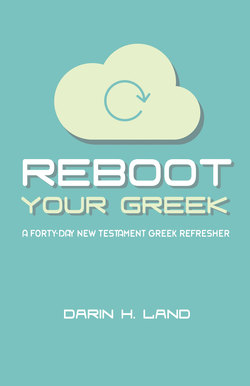Читать книгу Reboot Your Greek - Darin H. Land - Страница 7
Day 2: A Great Tool, the GNT Reader’s Edition
ОглавлениеYesterday I introduced you to the single best tool I know for helping to read Greek, namely, the UBS Greek New Testament: A Reader’s Edition. As I mentioned yesterday, the Reader’s Edition replaces the apparatus with footnotes. Each footnote gives the lexical form of the word to which it refers, together with a suggested gloss for that word. In addition, the following information is given depending on the part of speech:
Noun—genitive ending and gender
Adjective—feminine and neuter forms (if they exist)
Verb—full parsing
These bits of information, especially the gloss, save you many hours of stress and confusion in looking up words in a lexicon. Instead of flipping backward and forward through a lexicon to find the word you’re looking for, a quick glance at the bottom of the page gives you the information you need. You can take a peek at the word, then keep right on going with your reading. No need to break the train of thought as you pause to wade through the secondary resources. And all you need to carry with you is the one Greek NT.
To take full advantage of this useful tool, it is helpful to keep a couple things in mind. First, the words included at the bottom of the page are words that occur less than thirty times in the NT. (It also includes verbs that are more common in terms of NT frequency, but tricky to parse—especially second aorists.) There’s a good chance that you only learned words occurring fifty times or more in the NT during your first encounter with Greek. If that is the case for you, then there are a fair number of words that you will not have learned before that are not listed in the Reader’s Edition footnotes.
There are a couple of options for how to approach this situation. One is to get a vocabulary builder tool (such as Bruce M. Metzger’s Lexical Aids for Students of New Testament Greek or Robert E. Van Voorst’s Building Your New Testament Greek Vocabulary) and learn the words in the gap. The second option is to use the appendix at the end of the Reader’s Edition, which consists of a simple lexicon of the words that occur thirty times and more in the NT. Whenever you encounter a word that you don’t know while reading, simply flip to the back of the text and look it up. The advantage of this method is that you don’t have to memorize words. Instead, you will eventually learn the words through use. The third option is a variant of the second one. For this approach, rather than looking up unknown words, use the context of the word to help you learn the meaning by observation. Probably a combination of option 2 and option 3 will yield the best long-term results.
As with any book, the Reader’s Edition GNT has some typographical errors, omissions, and other imperfections. Happily, there are very few of these kinds of problems in this edition. But when you encounter one, it can be frustrating. Most of the time when a footnote appears to be missing, the word was footnoted in a preceding verse on the same page. So when you think a word should be footnoted but isn’t, before attempting one of the options mentioned above, try looking for the word in the previous verse or two. If you can’t find it, then move on to option 2 or 3. If you try looking it up in the lexicon in the back and it’s not there, that probably means it is an omission. In that case, you can either stick with option 3, look up the word in a full-sized lexicon, or look up your verse in a modern translation and try to figure out the meaning of your word by the process of elimination.
Exercise 2
Directions: Look up the following verses in the UBS Greek New Testament Reader’s Edition.4 Skim as many of the verses as possible in the allotted thirty minutes (see the preface). As you look at each verse, see if there are any words you recognize. Also, pay attention to the footnotes. See how helpful they can be! Don’t worry too much about comprehension at this point. Celebrate those words you recognize (if any), but don’t feel bad about the ones you can’t figure out. We’ll build comprehension throughout the coming forty days. (If you are able to read all the verses within thirty minutes, you may either read them again or read another passage of your choice.)
| 1. Luke 2:522. Mark 10:143. John 3:164. Rom 3:235. Rom 6:236. Eph 2:8–97. 1 John 4:7–88. John 11:35 | 9. John 8:1210. Rom 1:1611. 2 Cor 12:912. Eph 3:20–2113. Rev 1:814. Rom 10:1315. Gal 1:10 |
Reminder: If you committed to spending an extra fifteen minutes per day, be sure to set aside time to do that today, too.
4. If you have chosen to use an electronic text rather than the Reader’s Edition, feel free to look up the same verses listed here. Practice looking up the meaning and parsing of words using the built-in tools.
